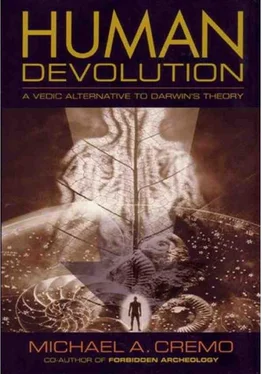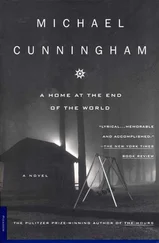Michael Cremo - Human Devolution - A Vedic Alternative To Darwin's Theory
Здесь есть возможность читать онлайн «Michael Cremo - Human Devolution - A Vedic Alternative To Darwin's Theory» весь текст электронной книги совершенно бесплатно (целиком полную версию без сокращений). В некоторых случаях можно слушать аудио, скачать через торрент в формате fb2 и присутствует краткое содержание. Год выпуска: 2003, ISBN: 2003, Издательство: Torchlight Publishing, Жанр: Старинная литература, на английском языке. Описание произведения, (предисловие) а так же отзывы посетителей доступны на портале библиотеки ЛибКат.
- Название:Human Devolution: A Vedic Alternative To Darwin's Theory
- Автор:
- Издательство:Torchlight Publishing
- Жанр:
- Год:2003
- ISBN:9780892133345
- Рейтинг книги:4 / 5. Голосов: 1
-
Избранное:Добавить в избранное
- Отзывы:
-
Ваша оценка:
- 80
- 1
- 2
- 3
- 4
- 5
Human Devolution: A Vedic Alternative To Darwin's Theory: краткое содержание, описание и аннотация
Предлагаем к чтению аннотацию, описание, краткое содержание или предисловие (зависит от того, что написал сам автор книги «Human Devolution: A Vedic Alternative To Darwin's Theory»). Если вы не нашли необходимую информацию о книге — напишите в комментариях, мы постараемся отыскать её.
Human Devolution: A Vedic Alternative To Darwin's Theory — читать онлайн бесплатно полную книгу (весь текст) целиком
Ниже представлен текст книги, разбитый по страницам. Система сохранения места последней прочитанной страницы, позволяет с удобством читать онлайн бесплатно книгу «Human Devolution: A Vedic Alternative To Darwin's Theory», без необходимости каждый раз заново искать на чём Вы остановились. Поставьте закладку, и сможете в любой момент перейти на страницу, на которой закончили чтение.
Интервал:
Закладка:
I define mind as a subtle, but nevertheless material, energy, associated with the human organism and capable of acting on ordinary matter in ways we cannot explain by our current laws of physics. Evidence for this mind element comes from scientific research into the phenomena called by some “paranormal” or “psychical.” Here we are led into the hidden history of physics. Just as in archeology, there has been in physics a tremendous amount of knowledge filtration. For example, every physics student learns about the work of Pierre and Marie Curie, the husband and wife team who both received Nobel Prizes for their work in discovering radium. The account is found in practically every introductory physics textbook. What we do not read in the textbooks is that the Curies were heavily involved in psychical research. They were part of a large group of prominent European scientists, including other Nobel Prize winners, who were jointly conducting research into the paranormal in Paris early in the twentieth century. For two years, the group studied the Italian medium Eusapia Palladino (sometimes spelled Paladino, or Paladina). Historian Anna Hurwic notes in her biography of Pierre Curie (1995, p. 247), “He thought it possible to discover in spiritualism the source of an unknown energy that would reveal the secret of radioactivity. . . . He saw the séances as scientific experiments, tried to monitor the different parameters, took detailed notes of every observation. He was really intrigued by Eusapia Paladino.” About some séances with Eusapia, Pierre Curie wrote to physicist Georges Gouy in a letter dated July 24, 1905: “We had at the Psychology Society a few séances with the medium Eusapia Paladina. It was very interesting, and truly those phenomena that we have witnessed seemed to us to not be some magical tricks—a table lifted four feet above the floor, movements of objects, feelings of hands that pinched you or caressed you, apparitions of light. All this in a room arranged by us, with a small number of spectators all well known and without the presence of a possible accomplice. The only possible cheating would be an extraordinary ability of the medium as a magician. But how to explain the different phenomena when we are holding her hands and legs, and the lighting of the room is sufficient to see everything going on?” On April 14, 1906, Pierre wrote to Gouy: “We are working, M. Curie and me, to precisely dose the radium by its own emanations. . . . We had a few new ‘séances’ with Eusapia Paladina (We already had séances with her last summer). The result is that those phenomena exist for real, and I can’t doubt it any more. It is unbelievable, but it is thus, and it is impossible to negate it after the séances that we had in conditions of perfect monitoring.” He concluded, “There is, according to me a completely new domain of facts and physical states of space of which we have no idea.”
To me, such results, and many more like them from the hidden history of physics, suggest there is associated with the human organism a mind element that can act on ordinary matter in ways we cannot easily explain by our current physical laws. Such research continues today, although most scientists doing it are concentrating on microeffects rather than the macroeffects reported by Pierre Curie. For example, Robert Jahn, head of the engineering department at Princeton University, started to research the effects of mental attention on random number generators. A random number generator will normally generate a sequence of ones and zeros, with equal numbers of each. But Jahn, and his associates who have continued the research, found that subjects can mentally influence the random number generators to produce a statistically significant greater number of ones than zeros (or vice versa).
Evidence for a conscious self that can exist apart from mind and matter comes from medical reports of out-of-body experiences (OBEs). Dr. Michael Sabom, an American cardiologist, conducted extensive research into out-of-body experiences. He carefully interviewed heart attack patients who reported such experiences. He then compared their reports with their actual medical records. He found that a statistically significant number of the group gave correct accounts, consistent with the reports of their treatment. This is highly unusual, because according to standard medical opinion, the patients should have been completely unconscious. Could the subjects have manufactured their correct reports from their previous knowledge of heart attack treatment procedures (for example, from watching television hospital dramas)? To control for this, Sabom selected a second group of heart attack patients who did not report OBEs. He asked them to imagine the medical treatment they had undergone while unconscious. None of them was able to give a correct report, and almost all of them made major mistakes. For Sabom, the results from the control group confirmed the genuineness of the OBE reports from the first group. In his book Recollections of Death: a medical Investigation (1982, p. 183), Sabom asked, “Could the mind which splits apart from the physical brain be, in essence, the ‘soul,’ which continues to exist after final bodily death, according to some religious doctrines?”
Sabom’s results have been confirmed by further studies. For example, in February 2001, a team from the University of Southampton, in the United Kingdom, published a favorable study on OBEs in cardiac arrest patients in the journal Resuscitation (v. 48, pp. 149–156). The team was headed by Dr. Sam Parnia, a senior research fellow at the university. On February 16, 2001, a report published on the university’s web site said that the work of Dr. Parnia “suggests consciousness and the mind may continue to exist after the brain has ceased to function and the body is clinically dead.”
Past life memories also give evidence for a conscious self that can exist apart from the body. Dr. Ian Stevenson, a psychiatrist at the University of Virginia medical school, has conducted extensive research into past life memories. Stevenson, and his associates, have focused on past life memories spontaneously reported by very young children. Stevenson prefers working with children because older persons might have the motives and means to construct elaborate past life accounts. His technique is to thoroughly interview the child subjects and thus obtain as many details as possible about the reported past life. Using this information, Stevenson and his associates then attempt to identify the person the child claims to have been in the past life. In hundreds of cases, they have been successful in making such identifications.
Having established that the human organism is composed of the elements matter, mind, and consciousness (or spirit), it is natural to suppose that the cosmos is divided into regions, or levels, of matter, mind, and consciousness, each inhabited by beings adapted to life there. First, there is a region of pure consciousness. Consciousness, as we experience it, is individual and personal. This suggests that the original source of conscious selves is also individual and personal. So in addition to the individual units of consciousness existing in the realm of pure consciousness, there is also an original conscious being who is their source. When the fractional conscious selves give up their connection with their source, they are placed in lower regions of the cosmos predominated by either the subtle material energy (mind) or the gross material energy (matter). There is thus a cosmic hierarchy of conscious beings. Chapter 7 of Human Devolution establishes the existence of this cosmic hierarchy of beings in a cross-cultural study of cosmologies, using the Vedic cosmology of the Shrimad Bhagavatam as a model for comparison. The cosmologies share many features. They generally include an original God inhabiting a realm of pure consciousness, a subordinate creator god inhabiting a subtle material region of the cosmos along with many kinds of demigods and demigoddesses, an earthly realm inhabited by humans like us, and an underworld inhabited by ghosts and demons.
Читать дальшеИнтервал:
Закладка:
Похожие книги на «Human Devolution: A Vedic Alternative To Darwin's Theory»
Представляем Вашему вниманию похожие книги на «Human Devolution: A Vedic Alternative To Darwin's Theory» списком для выбора. Мы отобрали схожую по названию и смыслу литературу в надежде предоставить читателям больше вариантов отыскать новые, интересные, ещё непрочитанные произведения.
Обсуждение, отзывы о книге «Human Devolution: A Vedic Alternative To Darwin's Theory» и просто собственные мнения читателей. Оставьте ваши комментарии, напишите, что Вы думаете о произведении, его смысле или главных героях. Укажите что конкретно понравилось, а что нет, и почему Вы так считаете.












